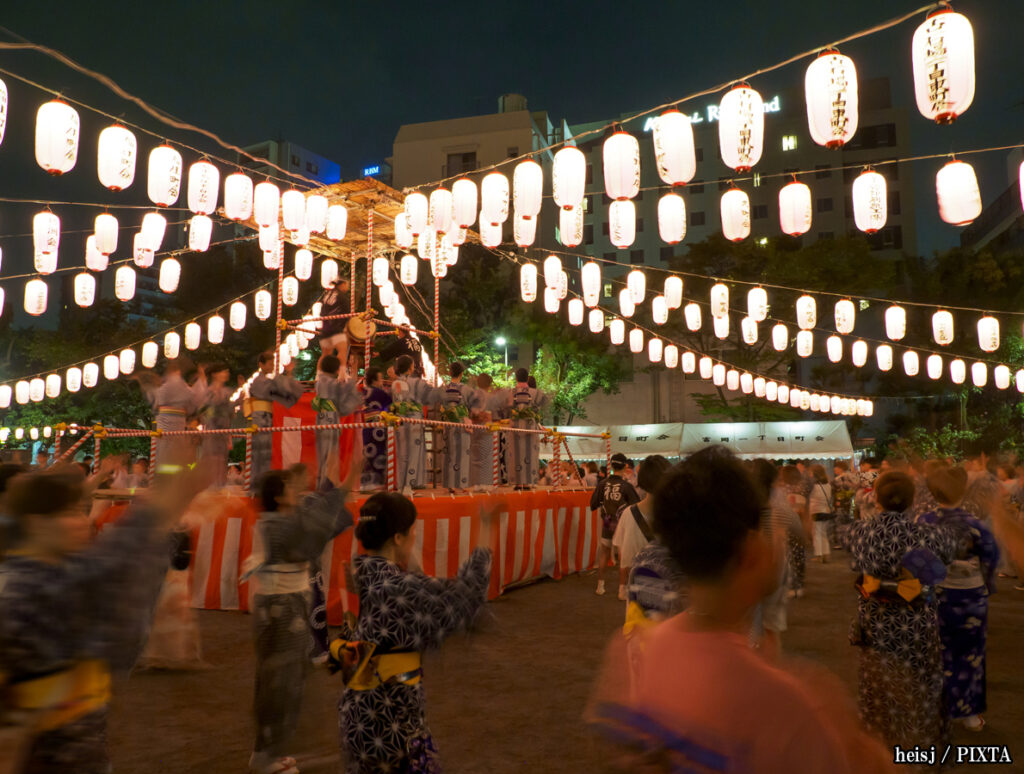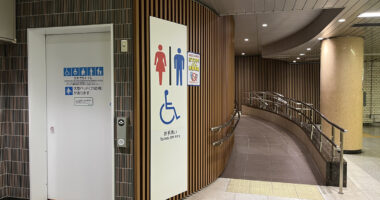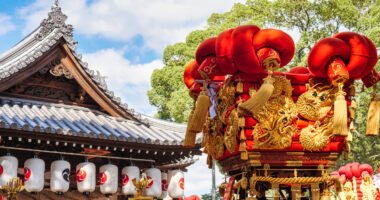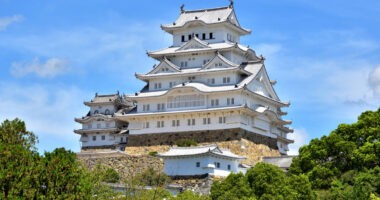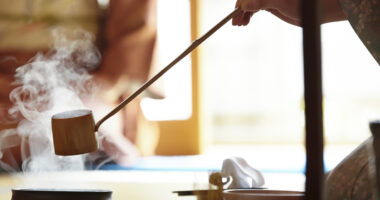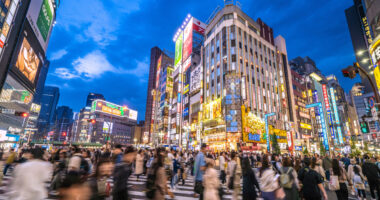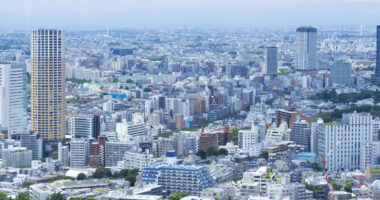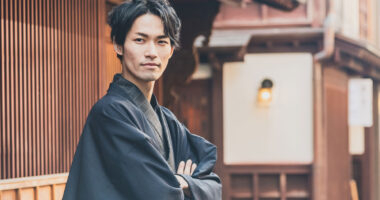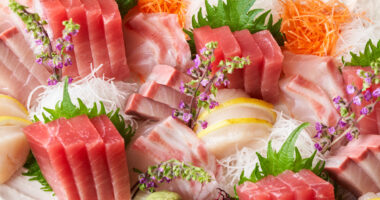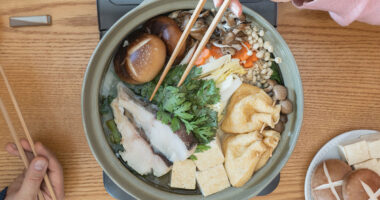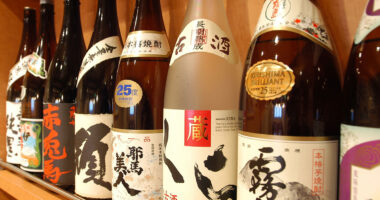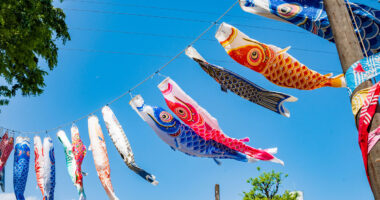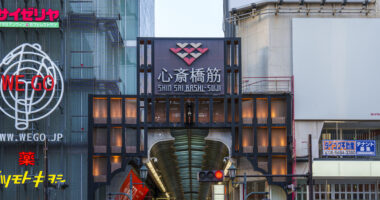Each summer, as Japan is bathed in warm evenings and lanterns begin to flicker in the twilight, something profound stirs beneath the surface of the season. Trains fill up, streets slow down, and in thousands of homes, incense wafts gently toward the heavens. This is Obon, one of Japan’s most cherished and quietly powerful traditions.
For travelers visiting Japan in July or August, understanding Obon is more than just a cultural curiosity. Whether you’re navigating your itinerary or simply seeking deeper cultural insight, understanding what to expect during Obon in Japan can turn a regular trip into something far more meaningful. Let’s explore!
What is Obon, and why is it celebrated?
Obon is a Japanese holiday when families honor and welcome the spirits of their ancestors. It’s believed that during Obon, the souls of the departed return to visit, so homes and temples are filled with rituals, dances, and gatherings.
Obon’s origins trace back to a Buddhist story in which a disciple frees his mother’s spirit through acts of compassion. Over time, Buddhist and local customs blended, shaping Obon into a festival of remembrance, gratitude, and joyful reunion.
While it’s not an official public holiday, Obon is observed with such reverence that many workplaces close, families travel across the country to reunite, and towns spring to life with traditional dances and ceremonies.
When is Obon held?
Obon doesn’t fall on a fixed national date. It varies by region, which confuses travelers, especially those planning to attend events or avoid peak travel congestion. However, in most parts of Japan, Obon is observed over four days from August 13 to 16. Regardless of the timing, the spirit of the holiday remains the same: honoring and welcoming ancestral spirits.
If you’re traveling in Japan in mid-August, you’re almost guaranteed to witness some form of Obon-related activity. Here’s a quick-reference table for clarity:
| Region | Obon Dates | Notes |
|---|---|---|
| Parts of eastern Japan (most of Tokyo, Yokohama, Shizuoka); parts of Kanazawa (Ishikawa); Hakodate (Hokkaido) | July 13–16 | Known as shichigatsu bon (July Bon), or shin bon (new Bon) |
| Most of Hokkaido, Honshu, Shikoku and Kyushu | August 13–16 | Known as kyū bon (old Bon), the most widely observed dates in Japan |
| Okinawa and some islands in Kagoshima | Mid-August to Early September | Based on the lunar calendar, dates shift yearly |
At the heart of Obon
Obon is often described as Japan’s spiritual equivalent of Thanksgiving, the Day of the Dead, or the Lunar New Year—not because of rituals, but because of that same idea that brings families together in deeply meaningful ways. Let’s have a look at how people prepare for Obon.
How do people prepare for Obon?
Preparation for Obon begins days, sometimes weeks, before the official holiday.
Here’s what families typically do:
- Clean and visit ancestral graves:
One of the most poignant customs during (but not exclusive to) Obon is ohaka mairi, or visiting ancestral graves. Families gather to clean tombstones and pull weeds. Not only this, they offer fresh flowers, food, and burn incense. It’s not a somber affair, but a quiet moment of reflection and thanks. This tradition speaks to the Japanese concept of giri (duty) and ninjō (emotion) that blends responsibility with heartfelt connection.
As a visitor, if you come across families tending to graves or temples decorated with offerings, it’s a moment worth observing—silently and respectfully. - Set up altars:
In preparation for Obon, families carefully clean and decorate their permanent butsudan (Buddhist altar), often placed in a central spot of the home. A temporary additional altar is usually placed in front of it. The altars are adorned with offerings like fresh flowers, incense, seasonal fruits, and around the altar, special decorative chōchin lanterns are placed to help and guide ancestral spirits back home. For many, setting up the butsudan for Obon is a way to create a sacred, welcoming space, blending tradition with personal remembrance. - Shop for Obon goods:
In the weeks leading up to Obon, markets and shops come alive with seasonal items. Families shop for essential items that are used for/in decorations, offerings, and rituals. These preparations turn shopping into a ritual of its own, as each item carries symbolic meaning in the broader tapestry of Obon traditions. - Return to one’s hometown:
The notion of furusato, or “hometown,” plays a powerful role in Japanese culture. During Obon, millions of people return to their family homes, sometimes traveling from big cities like Tokyo or Osaka to smaller rural towns. This mass movement transforms the country’s transportation network into a surge of reunions and emotional returns.
For travelers, this can mean bustling trains, sold-out accommodations, and packed highways. However, with awareness and preparation, it’s also a rare opportunity to witness Japan’s cultural rhythms in motion.
Special highlight: yukata
While there’s no formal dress code, you’ll notice many locals, especially at festivals, wearing yukata, a light kimono, usually made of cotton, that’s both comfortable and traditional. Travelers are welcome to wear them too, and they’re widely available for rent or purchase in major cities.
Traditions and celebrations
While the spiritual side of Obon centers on home and family, the public face of Obon bursts into life through festivals, dances, and glowing rituals. Let’s uncover them one by one!
Mukaebi and okuribi: welcoming and sending off spirits
Among the most visually striking traditions of Obon are the ritual fires that mark the arrival and departure of ancestral spirits. For example, in most of Japan where kyū bon is celebrated, on August 13, families light mukaebi (welcoming fires) at their doorsteps to guide spirits home. On August 16, okuribi (farewell fires) help them return to the afterlife. In Kyoto, this is observed on a grand scale with the gozan no okuribi—massive bonfires lit on the sides of five mountains (gozan) in the shape of symbols and kanji characters.
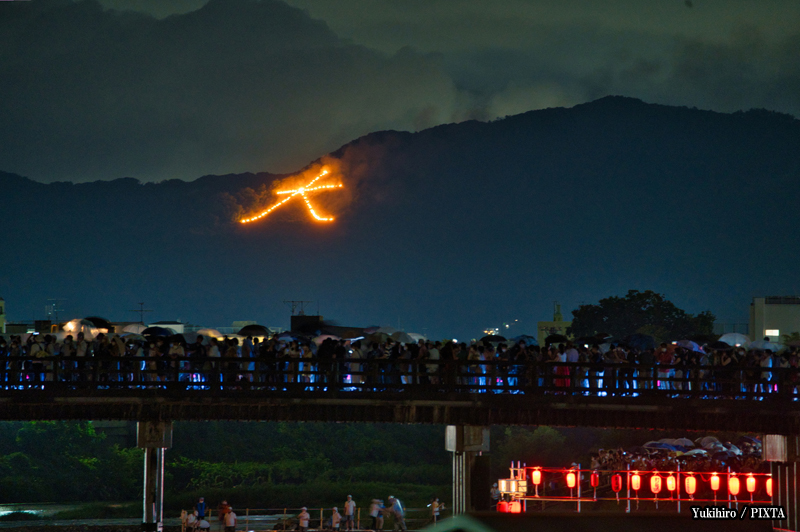
Photo for illustrative purposes
Bon odori: community dances that welcome
Bon odori are traditional folk dances performed during Obon to welcome the spirits of the ancestors. Held in parks, temple courtyards, and schoolyards, Bon Odori invites locals and travelers alike to dance in circles around a raised stage called a yagura. These dances are often accompanied by taiko drums and traditional music.
Each region has its own style of Bon odori. Some are lively, others slow and graceful, but all are deeply symbolic. The movements during these dances often mimic agricultural tasks, like planting rice and scooping water, as a way to honor the hard work of past generations.
Tip for travelers:
Visitors are often encouraged to join in, and it’s one of the most inviting ways to connect with the spirit of the holiday. So, don’t be shy, and just follow the hand movements and smile. No one expects perfection—just participation.
Tōrō nagashi: the lanterns that guide
Lastly, as Obon comes to a close, communities gather by rivers, lakes, or even the sea for tōrō nagashi, lantern-floating ceremonies. It’s a visually stunning ritual that usually involves placing paper lanterns on rivers or lakes to guide spirits back to the other world. It’s an ethereal, unforgettable sight where flickering lanterns drift silently across the water under a dusky sky, making one of the most peaceful, poetic scenes of summer in Japan.
How does Obon affect travel in Japan?
Obon is one of the busiest travel periods in Japan, alongside Golden Week and New Year’s. If you’re traveling during Obon, timing is everything. Here’s what to be aware of:
- Shinkansen (bullet train) tickets sell out quickly, flights become expensive, highways are often jammed, and accommodations are at full capacity. Thus, booking early is not optional—it’s essential.
- Small, family-run restaurants and shops may close entirely for several days during Obon as owners return to their hometowns. Museums, banks, and smaller attractions may also operate on irregular hours. Even some larger chain restaurants operate on reduced hours, particularly in non-tourist areas. Therefore, don’t forget to keep notes of the timings!
Tip:
If you’re using a Japan Rail Pass, reserve your seats well in advance. Moreover, don’t assume smaller towns will be less crowded—many Japanese return to their rural hometowns during Obon. Secondly, depachika (food halls in department stores, usually on basement levels) in major cities remain open and can be great places to sample seasonal Obon treats. Make sure you don’t miss that!
Can interntional tourists join in?
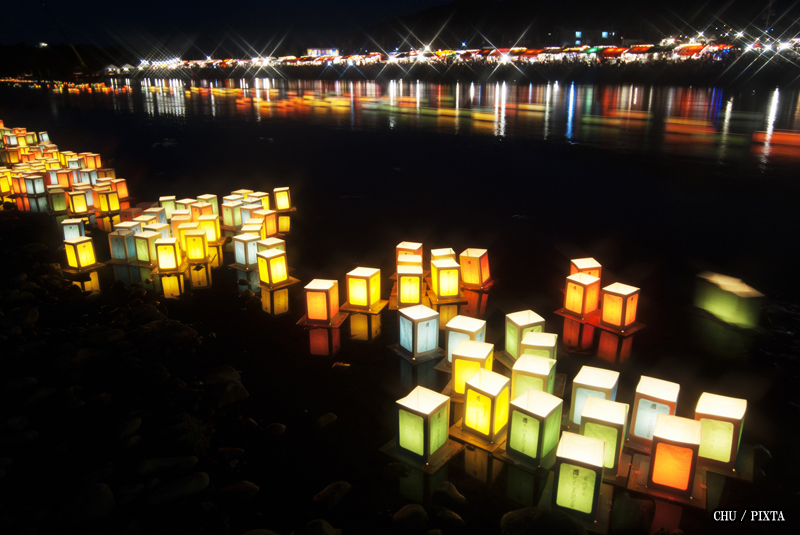
Photo for illustrative purposes
One of the beautiful things about Obon is how inclusive it can be, especially when it comes to public events. Here’s how travelers can respectfully experience this Japan holiday:
- Join a Bon odori dance:
These are often held in parks or temple grounds and are open to all. Some provide simple dance instructions on-site or through signage. - Attend a toro nagashi ceremony:
Even as a spectator, this event can leave a deep impression. Just observe quietly and avoid using flash photography. Events take place near rivers, like in Asakusa (Tokyo) or Hiroshima Peace Park. - Visit temples and shrines:
While they may be more crowded, many hold Obon-specific rituals. Some may even offer written explanations in English. - Try seasonal foods:
From cold soba to seasonal sweets offered during festivals, Obon is also a time of culinary tradition.
Remember that this is a time of spiritual reflection. While festivals are festive, there’s always an undercurrent of reverence. Dress modestly, be mindful of noise levels, and follow the lead of locals in public ceremonies.
Extra insight: notable Obon festivals accessible with a Japan Rail Pass
Awa Odori (Tokushima City, Tokushima)
One of Japan’s biggest and most dynamic dance festivals is Awa Odori in Tokushima, Shikoku. Held on August 11-15, it features costumed dancers parading through the city with flutes, drums, and shamisen. You can easily reach it via the JR from Okayama.
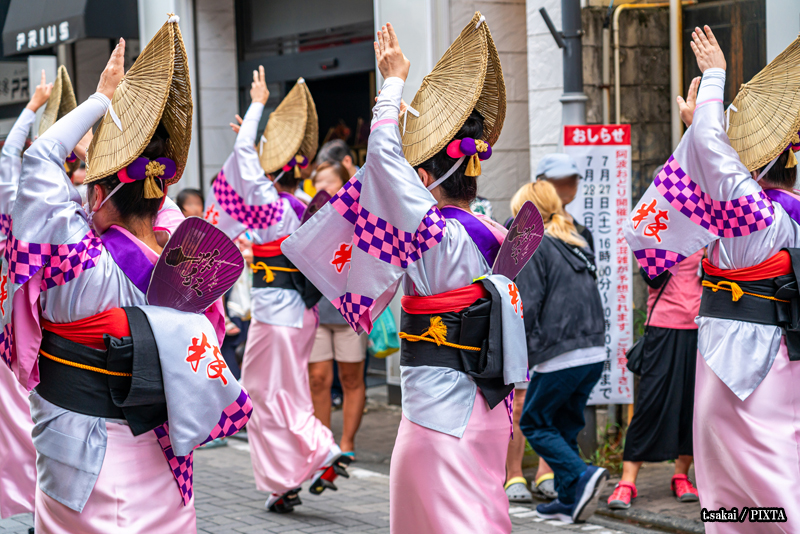
Photo for illustrative purposes
Gujō Odori (Gifu)
The Gujō Odori is one of Japan’s most celebrated Bon dance festivals, held annually in Gujō Hachiman, a picturesque mountain town in Gifu Prefecture. The festival spans 30-32 nights, from mid-July to early September, featuring all-night dances across various locations in the town. It’s reachable by JR to Gifu, then by bus.
How to be respectful during Obon?
Japanese culture is incredibly welcoming, but certain gestures go a long way in showing that you’re not just visiting—you’re learning.
- At cemeteries or graveyards, maintain a respectful distance. Avoid walking directly in front of altars or taking photos unless you’re sure it’s allowed.
- If you participate in Bon Odori, be aware of the space around you and follow the flow. These dances are communal, not performances.
- When observing religious rituals, keep phones silent and avoid interrupting moments of prayer or incense offerings.
A little awareness goes a long way in showing appreciation for the culture you’re experiencing.
Final thoughts
Obon isn’t just a date on the calendar or another colorful festival tucked into Japan’s vibrant summer. It’s a deeply human moment—a quiet, nationwide pause that invites reflection, remembrance, and reconnection. For the Japanese, it’s a time to honor where they came from. However, for travelers, it’s an opportunity to glimpse something rarely seen.
Obon is the kind of experience that doesn’t shout—it whispers. If you’re willing to listen, it can leave an echo that follows you long after your trip ends. Thus, in a world that rarely slows down, Obon reminds us that sometimes the most meaningful journeys aren’t just through places, but through time, memory, and connection.
So, if you find yourself in Japan this summer, don’t just pass through Obon. Let it pass through you.
Ready to experience Japan in a deeper way?
This Obon season, let your travels be guided not just by places, but by stories, memories, meaning, and the quiet power of tradition. Wherever your summer path leads, take a moment to pause and feel. Sometimes, the most unforgettable journeys are the ones that slow you down.
If you’re ready to explore Japan beyond the surface, follow Umami bites for thoughtful guides, cultural insights, and curated tips that turn your Japan trip into something truly unforgettable.
